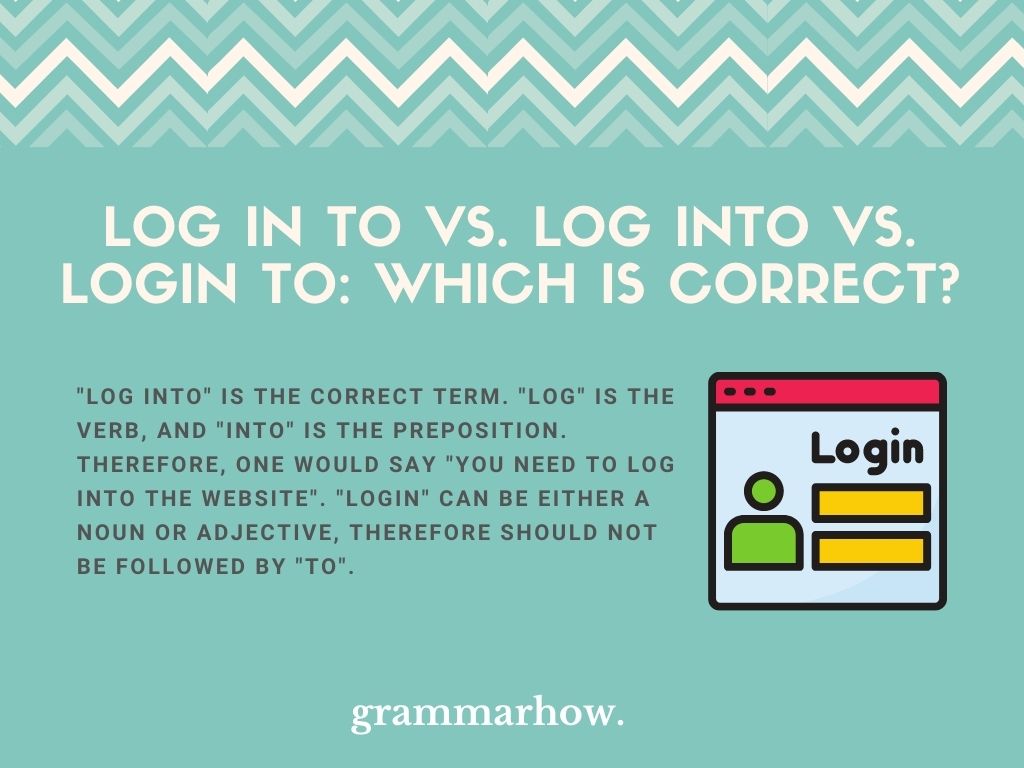When you put in your username and password, people will often refer to this as “logging in”. But when you’re giving someone else instructions about logging in, what is the correct term to use? Today, we’ll look at three contenders: log in to, log into, and login to.
We’ll also look at some of the English language’s nuances that explain why this question is a bit confusing.
Log In To Vs. Log Into Vs. Login To: Which Is Correct?
“Log into” is the correct term. “Log” is the verb, and “into” is the preposition. Therefore, one would say “You need to log into the website”. “Login” can be either a noun or adjective, therefore should not be followed by “to”.

Login Can Be A Noun Or Adjective
How Login Can Be A Noun
Many of us think of nouns as physical objects that we can touch. However, whilst all physical objects are nouns, not all nouns are physical objects.
Some nouns are abstract nouns. These are things that you can’t pick up, but they are still a thing, and not an action or descriptive word.
As a noun, “login” is an abstract noun. If I ask for your “login”, I am asking for information such as username, password, or email address.
You can’t physically touch a username or password, yet, it still counts as a noun.
How Login Can Be An Adjective
The word “login” can also be used as an adjective. As you may remember from your English teacher, an adjective is a word used to describe a noun.
When we use “login” as an adjective, we are describing something related to logging in.
If I say “Go to the login page”, then “login” is the adjective, and “page” is the noun that it’s describing.
In a way, “login” as a noun is an adjective in disguise. Because when I ask for your “login”, what I’m really asking for is your login information.
You can have login pages, information, emails, documents, etc.
Into Vs In To: What A Difference A Space Makes
Two of the options in the title are “log in to” and “log into”. But what exactly is the difference between “into” and “in to”.
It should go without saying that “into” is a single word. It’s a preposition that expresses movement towards something else. When you log into a website you’re moving from the login page to the main page.
To illustrate the differences, let’s look at a few examples.
- RIGHT- “I went into the building”- I was outside, then I was in the building.
- WRONG- “I went in to the building”- I went in (somewhere) to do an activity called “the building”.
- RIGHT- “I went in to drink”- I went in (somewhere) to do the activity of drinking.
- WRONG- “I went into drink”- I went into a place called “drink”.
Log (On A Computer) Is Not Something You Fall Off
The Definition Of Log
As we established right at the beginning, the word “log” is a word. But what does it mean to “log” something?
The word “log” predates the internet by a long time. And “log in” is one of the more recent adaptations of this word.
Before the internet, the word “log” meant to enter information into a sheet or paper database. If I got hurt, I may have had to log the accident in some kind of accident book.
The Definition Of Log In
Since the internet has become a thing, it’s now common for the verb “log” to be followed by the prepositions “in” or “into”.
It seems strange that a word that means writing down information is what gives you the ability to access more websites. But, think about it.
When you “log into” a website, you are entering information (logging it) to get into a new website.
Perhaps “sign in” would be better, since you’re not writing down new information, but alas, that’s just how it is.
11 Examples Of “Log Into”
- “Before we can do anything else, you’re going to have to log into the website”
- “You have to log into Facebook before you’re able to send messages, like posts, or send friend requests”
- “Please log into the database using the password that we gave you, and then we’ll send you all the information you need to know about starting your new job”
- “Don’t log into that website. I’ve heard that if you do, it’s likely that your computer will become infested with all sorts of viruses”
- “I had to log into the intranet to be able to see what was posted. I don’t think this kind of information should be hidden from public view”
- “Don’t log into any website that you aren’t sure about. Internet safety is very important these days, and you need to be careful that you don’t come across anyone bad. It’s better to be safe than sorry”
- “When you first log into Twitter, you might find it a bit overwhelming. But, once you get used to it, it’s some of the most fun you can possibly have”
- “I tried to log into the website, but for some reason, it kept saying that my email hasn’t been verified yet. I wasn’t aware that I had to verify my email?”
- “I had to log into the website today. I’ve never had to do that before. Perhaps they only want people reading their articles who they can spam with adverts in their email”
- “50 years ago, I had to log into these kinds of websites if I wanted to use them. Thankfully, the law has changed so they can’t do that anymore.”
- “Please remember, it should take no more than 5 minutes for your users to log into your website. If it takes longer, you need to rethink your whole website”.
Conclusion
And now you know that the correct term is “log into”. The phrases “log in to” and “login to” are both incorrect.
This is because “log” is a verb meaning to write information down. And “into” is a preposition that means “going from one place to another”.
To “log into” a website means to write information down that enables you to go from the login page to the actual website.
Although “login” is a word, because it’s either a noun or adjective, not a verb, it should never be followed with “to”.
And because we’re going from one place to another, not in somewhere to do something, we need to always say “into” and never “in to” when talking about logging in.
Now, if you’re creating your own website, you know the correct terminology to use.

Martin holds a Master’s degree in Finance and International Business. He has six years of experience in professional communication with clients, executives, and colleagues. Furthermore, he has teaching experience from Aarhus University. Martin has been featured as an expert in communication and teaching on Forbes and Shopify. Read more about Martin here.
